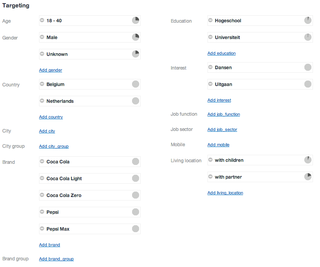Market segmentation is the activity of dividing a broad consumer or business market, normally consisting of existing and potential customers, into sub-groups of consumers based on some type of shared characteristics.

Advertising management is a planned managerial process designed to oversee and control the various advertising activities involved in a program to communicate with a firm's target market and which is ultimately designed to influence the consumer's purchase decisions. Advertising is just one element in a company's promotional mix and as such, must be integrated with the overall marketing communications program. Advertising is, however, the most expensive of all the promotional elements and therefore must be managed with care and accountability.

An advertising campaign is a series of advertisement messages that share a single idea and theme which make up an integrated marketing communication (IMC). An IMC is a platform in which a group of people can group their ideas, beliefs, and concepts into one large media base. Advertising campaigns utilize diverse media channels over a particular time frame and target identified audiences.
Brand loyalty is defined as positive feelings towards a brand and dedication to purchase the same product or service repeatedly now and in the future from the same brand, regardless of a competitor's actions or changes in the environment. It can also be demonstrated with other behaviors such as positive word-of-mouth advocacy. Brand loyalty is where an individual buys products from the same manufacturer repeatedly rather than from other suppliers. Businesses whose financial and ethical values, for example ESG responsibilities, rest in large part on their brand loyalty are said to use the loyalty business model.
Neuromarketing is a commercial marketing communication field that applies neuropsychology to marketing research, studying consumers' sensorimotor, cognitive, and affective response to marketing stimuli. Neuromarketing seeks to understand the rationale behind how consumers make purchasing decisions and their responses to marketing stimuli in order to apply those learnings in the marketing realm. The potential benefits to marketers include more efficient and effective marketing campaigns and strategies, fewer product and campaign failures, and ultimately the manipulation of the real needs and wants of people to suit the needs and wants of marketing interests.
Psychographics is a qualitative methodology used to describe consumers on psychological attributes. Psychographics have been applied to the study of personality, values, opinions, attitudes, interests, and lifestyles. Because this area of research focuses on activities, interests, and opinions, psychographic factors are sometimes abbreviated to 'AIO variables'.
In marketing, segmenting, targeting and positioning (STP) is a broad framework that summarizes and simplifies the process of market segmentation. Market segmentation is a process, in which groups of buyers within a market are divided and profiled according to a range of variables, which determine the market characteristics and tendencies. The processes of segmentation, targeting and positioning are parts of a chronological order for market segmentation.
A target audience is the intended audience or readership of a publication, advertisement, or other message. In marketing and advertising, it is a particular group of consumers within the predetermined target market, identified as the targets or recipients for a particular advertisement or message. Businesses that have a wide target market will focus on a specific target audience for certain messages to send, such as The Body Shops Mother's Day advertisements, which were aimed at the children and spouses of women, rather than the whole market which would have included the women themselves.

Food marketing brings together the food producer and the consumer through a chain of marketing activities.
The following outline is provided as an overview of and topical guide to marketing:
Digital marketing is the marketing of products or services using digital technologies, mainly on the Internet, but also including mobile phones, display advertising,and any other digital medium. Digital marketing channels are systems based on the internet that can create, accelerate, and transmit product value from producer to the terminal consumer by digital networks.
Youth Marketing is a term used in the marketing and advertising industry to describe activities to communicate with young people, typically in the age range of 13 to 35. More specifically, there is the teen marketing, targeting people age 13 to 17, college marketing, targeting college-age consumers, typically ages 18 to 24, young adult marketing, targeting youngsters use professionals, typically ages 25 to 34.
Customer engagement is a business communication connection between an external stakeholder (consumer) and an organization through various channels of correspondence. This connection can be a reaction, interaction, effect or overall customer experience, which takes place online and offline. The term can also be used to define customer-to-customer correspondence regarding a communication, product, service or brand. However, the latter dissemination originates from a business-to-consumer interaction resonated at a subconscious level.
A target market is a group of customers within a business's serviceable available market at which a business aims its marketing efforts and resources. A target market is a subset of the total market for a product or service.

Targeted advertising is a form of advertising, including online, that is directed towards audiences with certain traits, based on the product or person the advertiser is promoting. These traits can either be demographic which are focused on race, economic status, sex, age, the level of education, income level and employment or they can be psychographic focused which are based on the consumer's values, personality, attitudes, opinions, lifestyles and interests. They can also be behavioral variables, such as browser history, purchase history, and other recent activity. Targeted advertising is focused on certain traits and the consumers who are likely to have a strong preference will receive the message instead of those who have no interest and whose preferences do not match a product's attribute. This eliminates wastage.
Product Planning is the ongoing process of identifying and articulating market requirements that define a product's feature set. Product planning serves as the basis for decisions about price, distribution and promotion. Product planning is the process of creating a product idea and following through on it until the product is introduced to the market. Additionally, a small company must have an exit strategy for its product in case the product does not sell. Product planning entails managing the product throughout its life using various marketing strategies, including product extensions or improvements, increased distribution, price changes and promotions.
Advanced television is an array of features enabled by digital technology that significantly change analog television as it has come to be known during the 20th century. The term "advanced television" was first used at the MIT Media Lab in the early 1990s to explain why High definition television was only an early step in the foreseeable enhancements to the medium. In 1996, David Weiss defined "advanced television" in his book, Issues in Advanced Television Technology to describe "an agglomeration of techniques, based largely on digital signal processing and transmission, that permits far more program material to be carried through channels than existing analog systems can manage." Today, advanced television can be characterized by four features: time shifting, addressability, interactivity and interoperability.
The fields of marketing and artificial intelligence converge in systems which assist in areas such as market forecasting, and automation of processes and decision making, along with increased efficiency of tasks which would usually be performed by humans. The science behind these systems can be explained through neural networks and expert systems, computer programs that process input and provide valuable output for marketers.
Demographic targeting is a form of behavioral advertising in which advertisers target online advertisements at consumers based on demographic information.
Psychographic segmentation has been used in marketing research as a form of market segmentation which divides consumers into sub-groups based on shared psychological characteristics, including subconscious or conscious beliefs, motivations, and priorities to explain and predict consumer behavior. Developed in the 1970´s, it applies behavioral and social sciences to explore to understand consumers’ decision-making processes, consumer attitudes, values, personalities, lifestyles, and communication preferences. It complements demographic and socioeconomic segmentation, and enables marketers to target audiences with messaging to market brands, products or services. Some consider lifestyle segmentation to be interchangeable with psychographic segmentation, marketing experts argue that lifestyle relates specifically to overt behaviors while psychographics relate to consumers' cognitive style, which is based on their "patterns of thinking, feeling and perceiving".



